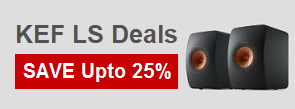Features
| Warranty length | 5 Years |
|---|---|
| Brand | Martin Logan |
Tech Specs
- Frequency Response: 23–22,000 Hz ±3dB
- Horizontal Dispersion: 30°
- Vertical Dispersion: 48" (122 cm) line source
- High Frequency Transducer: XStat™ CLS™ electrostatic transducer
- Panel Dimensions: 48" × 22" (121.9 × 55.9cm)
- Radiating Area: 1056 in2 (6,814 cm2)
- Low Frequency Transducer
- Rear: 15” (38.1cm) cast basket, high excursion, rigid aluminium cone with extended throw drive assembly.
- Front: 12” (30.5cm) round cast aluminium alloy frame, rigid carbon fibre sandwich cone with long throw design, 3-inch (7.5cm) diameter copper-clad aluminium flat wire voice coil, and vented pole piece and under-spider opening to reduce power compression.
- Sensitivity: 90 dB/2.83 volts/meter
- Impedance: Nominal: 4 ohms, 0.43 ohms @ 20 kHz. . Compatible with 4, 6, or 8 Ohm rated amplifiers.
- Recommended Amplifier Power: 20‒1300 watts per channel
- Crossover Frequency: 60, 250–400 Hz
- Audio Controls: Bass Control: 0dB, -4dB, -8dB, Distance Control: 3 meters (or less), 4 meters, 5 meters (or greater)
- Lighting: LED intensity control: On, Dim, Off
- Inputs: WBT-0705Ag nextgen™ 5-way bi-wire binding posts
- Power Draw: Standby: 1W each Max: 15W each
- Weight: 385 lbs. (175 kg)
- Dimensions: 74.8" × 30.3" × 34.2" (189.9cm × 76.9cm × 87cm)
Product Description
Martin Logan Neolith electrostatic speakers are the flagship speakers in the Martin Logan electrostatic speaker range. They are a masterpiece, made to order, in every case hand delivered and professionally installed. For truth in sound, the Neolith is likely unsurpassed.
The large 22”, radiating surface is 35% larger than the E2 and the curvilinear shape delivers a wide soundstage. The panel will deliver the entire mid-range and high frequency band. For bass frequencies there are two woofers that fire forward and backward. There are also two bass ports. The power handling is 1300 watts.
Neolith’s electrostatic panels
An electrostatic transducer has three parts, two stators, a diaphragm and spars. Spars are non-conductive spacers that keep the tall assembly apart. The diaphragm is mounted between the stators and is made of an ultra-light film that is coated with a conductive material. Notably, the stators are made of perforated sheet steel, that is then insulated.
To create sound, the diaphragm is charged with an electrostatic field, at a high fixed, positive voltage. Next the two stators are charged with the same voltage but opposite polarity, like the plates of a capacitor. Secondly, an audio signal is fed to the stators, via a step-up transformer. The audio signal forces the panel to move forwards and backwards generating sound.
100 years of electrostatic panels
Electrostatic panels have been around for 100 years. They were developed in the 1920s, although materials technology at the time was not really up to the job. Originally, the diaphragm was made of pig intestine, they were also leafed with gold. They sounded amazing but had several disadvantages. They needed more powerful amplifiers, did not have great bass, and suffered from “beaming”. This required that the listener sat in the “sweet spot” to get the best sound.
Since then Martin Logan has eliminated all of the problems, without losing the accuracy. For example, careful matching transformer design means that the Neolith can be driven by amplifiers down to 20 watts per channel. The bass is addressed by having two powerful woofers in the bass. While the beaming effect is eliminated by the curvilinear shape. The dipole effect is also used to generate more ambience.
Curvilinear Line Source (CLS) panels
Another unique feature of the Martin Logan range, is the curvilinear panel. The curve prevents the ‘beaming’ effect that can happen with electrostatic speakers. As a result the dispersion is much wider, creating a wide enveloping sound. Moreover, electrostatic panels are bipolar, in that the radiate sound from both sides. However, the signal is in opposite phase. This has the effect of nulling any sound from the sides. This reduces wall reflections, so that the sound is clearer and more detailed. Additionally, the sound from the rear enhances ambience.
Airframe panel mounting
The beautiful curvilinear shape is created by an Airframe mounting. The Airframe is made of aerospace-grade aluminium which makes the panel extremely rigid. However, the Airframe never obstructs the panel or interferes with the sound. The frame also provides electrical and acoustic isolation. This results in less intermodulation distortion as well as resonance. Finally, the curved shape also helps with high frequency dispersion
Punchy bass from two woofers
Low frequencies are not forgotten as the Neolith has two woofers. The rear firing woofer has a 15” cast basket along with a high excursion, rigid aluminium basket. Moreover, there is a long-throw drive assembly. Next the motor assembly is triple vented and has a 4-layer coil to eliminate compression and distortion. The forward firing 12” woofer is similar. Both drivers are mounted in individually enclosed compact chambers.
High-grade crossover
The high-grade cross-over uses 1% film resistors for accuracy. They are also mounted on heatsinks and do not drift in value with temperature. Next, Audio grade polypropylene capacitors are used. Air core inductors and toroidal inductors are also used in the crossover. Finally, the driver transformers for the panel are also toroidal.
Connectivity and control
The Neolith features a bass control as well as distance control. Next, the speaker connectors are no-compromise designs with WBT-0705Ag next-gen 5-way bi-wire binding posts. These feature a filigree signal conductor that is made from fine silver for high conductivity.
















































































